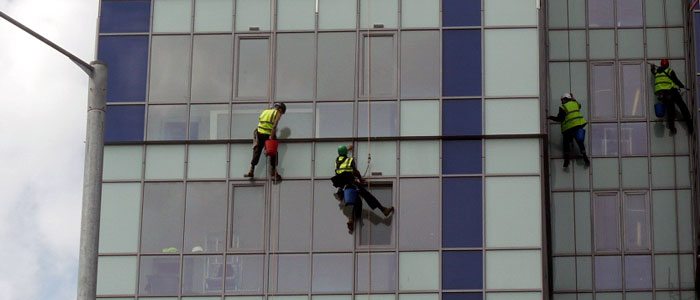
Rope Work / Abseil Window Cleaning
Industrial rope access methods
What is rope access?
The term “rope access” is intended to mean rope access for industrial purposes only (this includes industrial/commercial window cleaning).
Rope access methods were originally employed in the offshore oil and gas industry as a means of carrying out tasks such as structural surveys, inspections and non–destructive testing (NDT). However, it soon became apparent it also had other usages and advantages in the onshore industry due to its safe working methods, low cost, environmentally friendly, fast and efficient approach.
One of the major advantages it has, over other cleaning methods at height, is in its simple application in sometimes very difficult and challenging locations. Similar cleaning programmes utilising alternative methods often involve intensive planning, hours of risk and associated high costs which, in rope access terms, are low in comparison.
Why rope access?
As the world evolves, more and more architects, design engineers, heads of state and heads of government will continue to construct ever taller buildings, super structures or even challenging bespoke design builds which, will not only enforce the need for rope access and highly trained technicians to overcome these obstacles, but will eventually supersede where other forms of access can no longer reach.
Rope access methods must be utilised by implementing a safe system of work in accordance with the IRATA (Industrial Rope Access Trade Association) International Code of Practice (ICOP) 2014 and British Standard (BS 7985: 2013) and ISO 22846 parts one and two.
It must also be utilised in accordance with the Health and Safety at Work Act 1974 and The Work at Height Regulations 2005 and in this case following the hierarchy of control measures correctly at all times when implementing rope access methods.
TRAINING AND CERTIFICATION SCHEME
IRATA International has a formal training and certification scheme and grading structure, and all IRATA International members are obliged to use this scheme. Rope access technicians are grouped into three technical grades, depending upon their experience and level of assessment as set out in the IRATA International publication Training, Assessment and Certification Scheme (TACS).
The three technical grades are:
Level 1
This is a rope access technician who is able to perform a specified range of rope access tasks under the supervision of a Level 3.
Level 2
This is an experienced rope access technician who has Level 1 skills plus more complex rigging, rescue and rope access skills, under the supervision of a Level 3.
Level 3
This is a rope access technician who is capable of complete responsibility for rope access safety in work projects; is able to demonstrate the skills and knowledge required of Levels 1 and 2; is conversant with relevant work techniques and legislation; has an extensive knowledge of advanced rigging and rescue techniques; holds an appropriate and current first aid certificate and has knowledge of the IRATA training, assessment and certification scheme.
